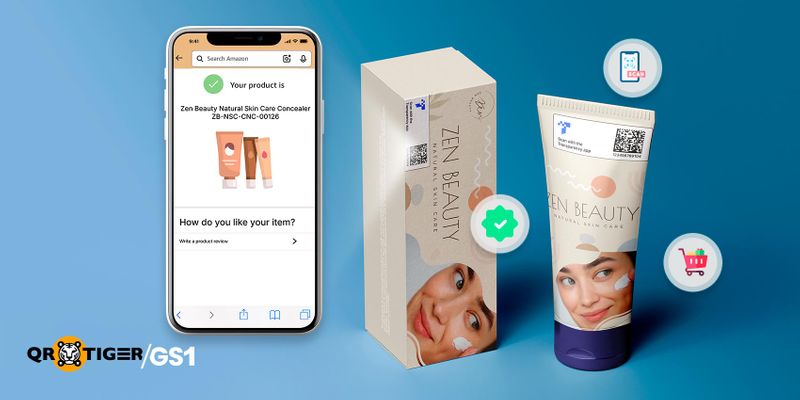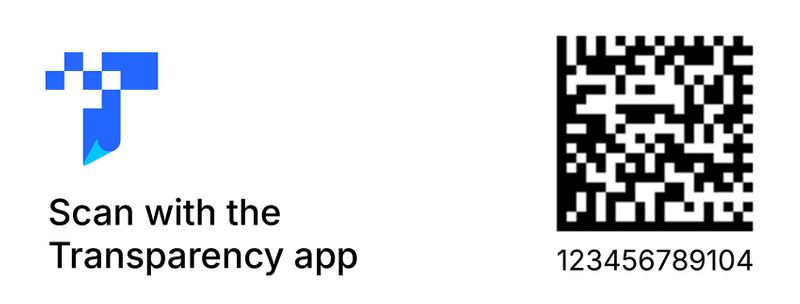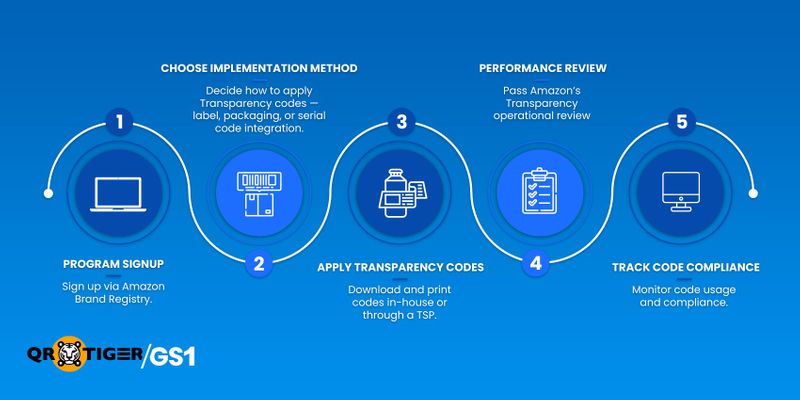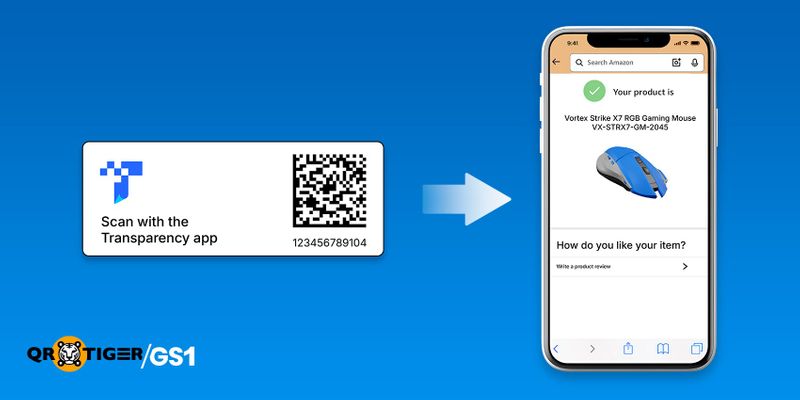Clarifying the Amazon Transparency Program

The Amazon Transparency Program is a product serialization service designed to help brand owners prevent counterfeiting and protect customers.
Once enrolled, each of your products is provided with an Amazon transparency code, a specialized barcode that can be scanned via the Amazon Shopping or the Transparency app to verify authenticity.
To make the program effective, every manufactured unit of an enrolled product must carry its own Transparency code, even if that item is sold outside Amazon. This ensures consistent protection across all sales channels.
Launched in 2017, it is available to Amazon-registered brand owners and managers The program is especially valuable for categories vulnerable to counterfeiting, such as electronics, branded apparel, and luxury items.
As of the latest available information, Transparency is generally active in the following countries/regions:
North America:
- United States
- Canada
Europe:
- Germany
- France
- Italy
- Spain
- United Kingdom
Asia & Pacific:
- Japan
- Australia
- India
Table of Contents
What Amazon Transparency Codes are
Transparency-enabled products include one of two common types of serial identifiers:
1. Amazon Generated
Amazon generates this code upon the brand’s request for each individual unit enrolled in the Transparency program.
This format uses a 26-character alphanumeric identifier that begins with “AZ:” or “ZA:”, with a total of 29 characters. It’s usually printed as a DataMatrix symbol and includes the Transparency “T” logo.

Example: AAZ:3K5Q2L8M4N6R7T9Y1C2B5Z4V6N
2. Serialized Global Trade Item Number (SGTIN)
This brand-generated code follows GS1 standards. It must be linked or registered within the Amazon Transparency program to function as a valid transparency identifier.
It uses Application Identifiers (AIs) in an element string format. It combines the product’s GTIN (AI 01) with a unique serial number (AI 21) for each unit.
Note: A GS1 Digital Link is not applicable in this application
2jpg_800.jpeg)
Example: 0100376204200301214P1OZMT7D8B81EMF4WW4
Breaking it down:
(01) → AI for GTIN
00376204200301 → Product’s GTIN (identifies the item type)
(21) → AI for serial number
4P1OZMT7D8B81EMF4WW4 → Unique serial number (7–20 characters long)
The total SGTIN length ranges from 25 to 38 characters, depending on the serial number length. It can be encoded in 1D barcodes (GS1-128) or 2D barcodes.
When creating a 2D symbol for an SGTIN, it is crucial to use compliant platforms like GS1 QR code generators to ensure the data structure and formatting comply with the GS1 element string syntax.
Brands using the SGTIN format may choose not to display the Transparency “T” logo, as long as the serial data itself is registered and verified within Amazon’s Transparency system.
What Amazon Transparency Codes are NOT?
Amazon Transparency codes must not be mistaken for other product barcodes; they serve a very different purpose. Here’s what they are not:
Here’s what they are not:
- Standard 2D barcodes (QR codes or DataMatrix) – While they may look similar, the key difference lies in the data embedded.
- GS1 Digital Link QR code – Although these use GS1 standards, they follow a URL-based format, not the element string format used in Transparency.
- Replacements for point-of-sale or checkout barcodes – Transparency codes are not used for pricing or retail scanning. Standard UPC, EAN, or GTIN-based barcodes are still required for those purposes.
- Marketing or tracking tools – Transparency codes do not link to promotional content or websites. Product details can only be accessed through the Amazon Transparency app or an authorized system.
How to place your product in the Amazon Transparency Program?
To join the Program, brands must meet certain requirements and follow a few setup steps. Let’s learn who’s eligible and how to get started.
Eligibility and enrollment
Here are the criteria to follow to enroll in the Amazon Transparency Program.
- You must have an active Amazon Brand Registry account. The account must be associated with your brand’s trademark and assigned the “right owner” role.
- You need to be the authentic brand owner with a government-registered trademark.
- Each product that you want to enroll in the program must have a Global Trade Item Number (GTIN).
- The ability and commitment to add codes to each unit you manufacture, regardless of where the units are sold.
Steps to include your products in the program

Step 1: Program Signup
If you fulfill all the eligibility requirements, enroll your brand in the Transparency program. First, you need to sign up for the Amazon Brand Registry (if you haven’t done it already). Use the same credentials you use to log in to the Brand Registry portal.
If your brand is already enrolled, log in to the Transparency portal to enroll products and add users to your account.
Note: You can join the Transparency program even if your trademark is still pending. In this case, use the Amazon IP Accelerator program that allows filing a trademark application via the Amazon-accredited firms and helps you join the Brand Registry faster.
Step 2: Decide how you will implement Transparency
There are three ways you can add Transparency codes to your products:
Use labels: Place Transparency labels on each product unit. These labels can be printed either in-house or through a Transparency Service Provider (TSP).
Print directly on the packaging: Include the Transparency code as part of your product’s printed design or packaging.
Link to existing serial numbers: If your products already have serial numbers, you can connect those to Transparency codes.
If you choose the third option, here are the key rules to follow:
- Every product unit under the same GTIN or SKU (Stock Keeping Unit) must have its own unique code.
- Use scannable barcodes (1D, QR, or 2D) placed on the same side as the GTIN.
- Each product code should be a unique serial number between 7 and 20 characters long.
- Brands must be able to provide a list of all serial numbers used for that GTIN or SKU when Amazon requests it.
Step 3: Apply Transparency codes to your units
Visit the Transparency portal to order and download transparency codes. Once you have them, you can choose how to apply them:
- Label in-house: Print and apply the labels directly at your facility.
- Contact a TSP: Share the downloaded file with an Amazon-authorized TSP who can print and deliver labels to your manufacturing site.
- Code integration: Integrate the codes into your product packaging design using the downloaded data.
- Automate with API: Use Amazon’s API to place code orders automatically or authorize a service provider to do it for you.
Note: If you want to link Transparency with your existing serial codes, visit the Amazon Brand Protection website and fill out the Transparency serial code eligibility form.
Step 4: Complete the Transparency operational performance review
Here are the available options to pass the Transparency operational performance review:
- Self-fulfillment: Email your Transparency contact to begin the review. When you confirm custom orders in Seller Central, include your Transparency codes so Amazon can begin tracking your units.
- Fulfilled by Amazon (FBA): Use the Transparency portal to begin the review. Once your products reach Amazon’s fulfillment centers, Amazon scans the codes.
Notes:
- Ignore this step if you are linking Transparency to existing serial codes.
- Transparency protection only activates after your products pass the review with at least 98% accuracy.
Step 5: Track code compliance
Once your product passes the Transparency performance review, every unit must include either:
- An Amazon-issued Transparency code, or
- A serial number you’ve already linked to Transparency
You will need to include a code each time you list the product in the Amazon store.
If you choose self-fulfillment, keep providing Transparency codes when confirming customer orders in Seller Central.
If you choose FBA, Amazon will continue scanning your codes when products arrive at its fulfillment centers.
Amazon investigates when units fail Transparency checks, and you can track your product’s performance in the Transparency portal.
Role of TSPs
TSPs are third-party companies authorized by Amazon to print Transparency labels for enrolled products. These labels carry unique Transparency codes that help verify product authenticity and prevent counterfeiting.
TSPs do not generate Transparency codes themselves. They only print labels using the codes provided by Amazon to the brand owner. These labels are then integrated into individual product units before shipment.
Benefits of using TSPs
- Optimizes label production for brands dealing with large inventories
- Saves resources and time by outsourcing the printing process
- Ensures consistent label quality and compliance with Amazon’s Transparency standards
- Ideal for manufacturers and sellers who require bulk label printing across multiple SKUs
How the Transparency Code Works

Transparency codes ensure each product unit is genuine and traceable toprotect both the brands and their customers.
The Code is central to Amazon’s anti-counterfeit strategy. This Amazon barcode is printed on each unit of a product enrolled in the Transparency Program. Now, let’s break down how this code works and how it’s applied.
Integration with Amazon’s fulfillment and seller systems
These codes are integrated into Amazon’s fulfillment workflows in the following way:
- FBA: Amazon scans each product to make sure it has a valid Transparency code before it’s shipped to the customer.
- Seller-fulfilled orders: If you ship products yourself, you need to apply the Transparency codes before dispatching them.
- Third-party resellers: They’re only allowed to sell products that already have Transparency codes provided by the brand owner.
This ensures that every product shipped, whether by Amazon or the seller, is genuine and verified with a Transparency code.
Scan using the Amazon shopping or the Transparency apps
When a Transparency code is scanned, the result is simple and clear. If the product is genuine, the screen shows a green circle with a check mark and the verified product name below it.
If the product fails verification, it displays a red circle with an X and the message, “We can’t verify the origin of this item.” A Contact Us button then appears, allowing customers to reach out directly for help or to report the issue.
This straightforward process makes it easy for customers to confirm authenticity in just a glance.
Note: The Transparency app may not be available in certain countries.
Customer engagement features
The code goes beyond confirming authenticity. It creates an interactive touchpoint between the customer and the brand. Depending on what the brand provides, the scan can display extra product details, short videos, or even manufacturing information.
Some brands also include direct links for customer engagement. These may allow users to write a product review, contact the brand’s customer support, or visit the brand’s official Amazon store.
How Transparency affects Amazon arbitrage?
Amazon arbitrage involves buying discounted products online or from physical stores and reselling them on Amazon for profit. Online arbitrage sources come from eCommerce sites, while retail arbitrage involves in-person purchases from clearance aisles, outlet stores, or liquidation sales.
However, the Amazon Transparency program changes the way these resellers operate. Once a brand enrolls, every unit of its product must carry a unique Transparency code. Without that code, Amazon’s system blocks listings and shipments, treating them as unverified inventory.
This creates a problem for arbitrage sellers holding older stock that lacks these codes. Even if the items are authentic, Amazon can flag or remove them once Transparency enforcement begins for that ASIN.
Here are options you can do if this happens:
Contact the Brand or Manufacturer Immediately
If you are an authorized reseller, reach out to the brand as soon as possible. They are the only ones who can issue the required Transparency codes or grant an exemption for older inventory.
What to ask for:
- Request the codes: Explain your situation clearly. Your inventory predates Transparency enrollment and needs unique codes for each unit in stock or at FBA. Brands usually send these as digital files (e.g., CSV (Comma Separated Value) file) or provide physical sticker labels.
- Ask about a grace period: Some brands may have negotiated a limited sell-through time for non-coded inventory. However, this depends entirely on the brand’s agreement with Amazon, so verify first.
- Confirm future orders: Ensure all new shipments from the brand include Transparency codes pre-applied to packaging.
Addressing Current Inventory in Amazon (FBA)
If your stock is already stored in an Amazon fulfillment center, you have three main options:
Option A: Sell Through (Hopeful Approach)
You might sell the inventory before Transparency enforcement activates. However, if the ASIN (Amazon Standard Identification Number) becomes protected sooner, those units may be blocked or flagged as counterfeit.
Option B: Create a Removal Order (Safe Approach)
You can remove the stock to avoid compliance issues. Removal, shipping, and relabeling cost time and money, but they prevent possible account risks.
Option C: Relabel with Transparency Codes (Compliant Approach)
If the brand provides valid codes, relabeling ensures full compliance and keeps the listings active. It’s labor-intensive but safest long-term.
Recommendation:
For small quantities of older inventory, Option A may work temporarily. For larger volumes, coordinate with the brand and plan for either removal or relabeling.
Addressing Inventory in Your Own Warehouse (FBM or Personal Stock)
If you fulfill orders yourself, Amazon will now require a Transparency code for each unit when confirming shipment.
You must relabel each product with the provided Transparency stickers before shipping.
No code, no ship: Failing to provide a valid code can result in flagged orders, policy violations, or listing suspensions.
Prepare for the Future
- Ensure codes are applied: Confirm that future purchase orders come with Transparency codes already printed or labeled on every unit.
- Adjust cost of goods: Some brands may add a small per-unit fee for codes and labeling labor. Include this in your pricing to maintain profitability.
 A Smart Move for Brand Protection
A Smart Move for Brand Protection
Enrolling in Amazon’s Transparency Program is more than just adding a barcode; it’s a strategic shift in how brands secure their products and customer relationships.
There are two main ways to obtain an Amazon Transparency code. Amazon can generate the codes directly and provide the image files for labeling.
Alternatively, brands can create their own Transparency codes using SGTINs that follow GS1 standards. These codes must be registered and activated within Amazon’s Transparency system to be valid. Once generated, they can be embedded in 2D barcodes, such as GS1 QR codes or GS1 DataMatrix, using the element string format.
Brands that want to build long-term trust and grow their business can join this program. It helps protect product authenticity and builds stronger customer confidence.
But joining means making a full commitment. The brand must label every product they enroll with its Transparency code. If they don’t, the program won’t work as intended, and they could risk violating Amazon’s Terms of Service.
Brands that follow through can use this program to protect their name and make sure customers always get genuine products.
FAQs
1. How does one scan a Transparency code using the Amazon Shopping app?
Open the Amazon Shopping app and look at the search bar at the top. Tap the camera icon on the right side of the bar. This opens Amazon Lens. At the bottom-right corner, select the barcode option. Then point your phone’s camera at the Transparency code to scan it.
2. Where should the Transparency label be placed on products?
The Transparency label should be positioned close to the main GS1 barcode (such as the UPC or EAN). It can appear as a printed design on the packaging or as a sticker, as long as it remains clear, visible, and easy to scan for verification.
3. What are the benefits of participating in Amazon's Transparency program?
Amazon’s Transparency program helps brands block counterfeit sales, protect their reputation, and ensure customers receive genuine products from Amazon. It also provides supply chain transparency, helps identify unauthorized sellers, and allows brands to connect with customers through post-purchase content.
Brands can enroll some or all products, as long as they apply Transparency codes to every unit manufactured for that product.
 DISCLAIMER: We acknowledge that GS1, as well as the materials, proprietary items, and all related patents, copyright, trademark, and other intellectual property (collectively, “intellectual property”) relating to its use, are the property of GS1 Global, and that our use of the same shall be in accordance with the conditions provided by GS1 Global.
DISCLAIMER: We acknowledge that GS1, as well as the materials, proprietary items, and all related patents, copyright, trademark, and other intellectual property (collectively, “intellectual property”) relating to its use, are the property of GS1 Global, and that our use of the same shall be in accordance with the conditions provided by GS1 Global.


